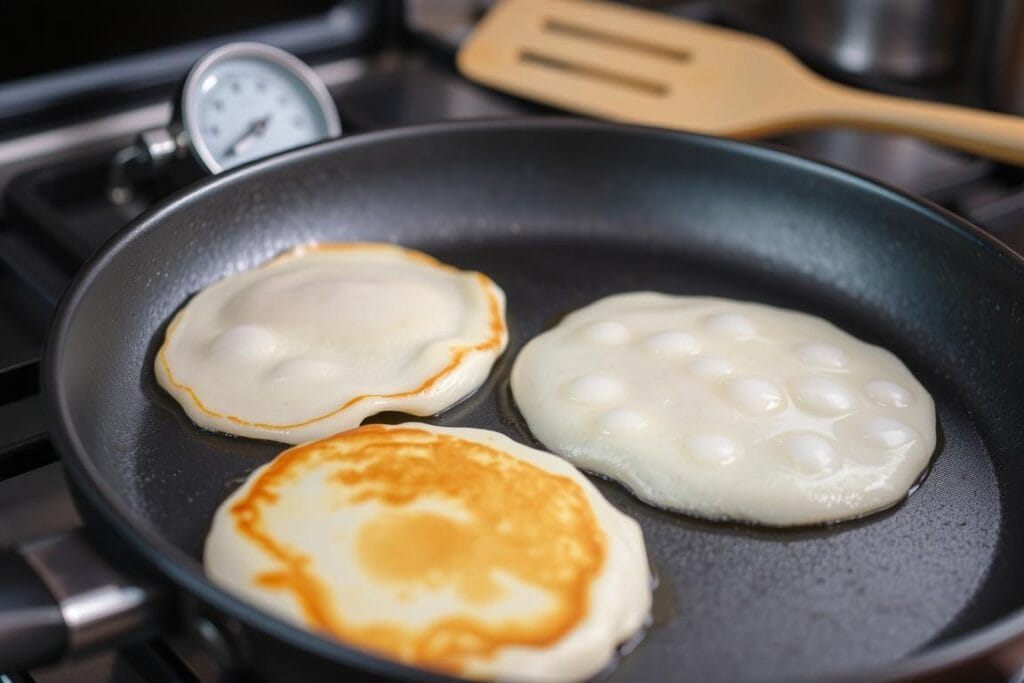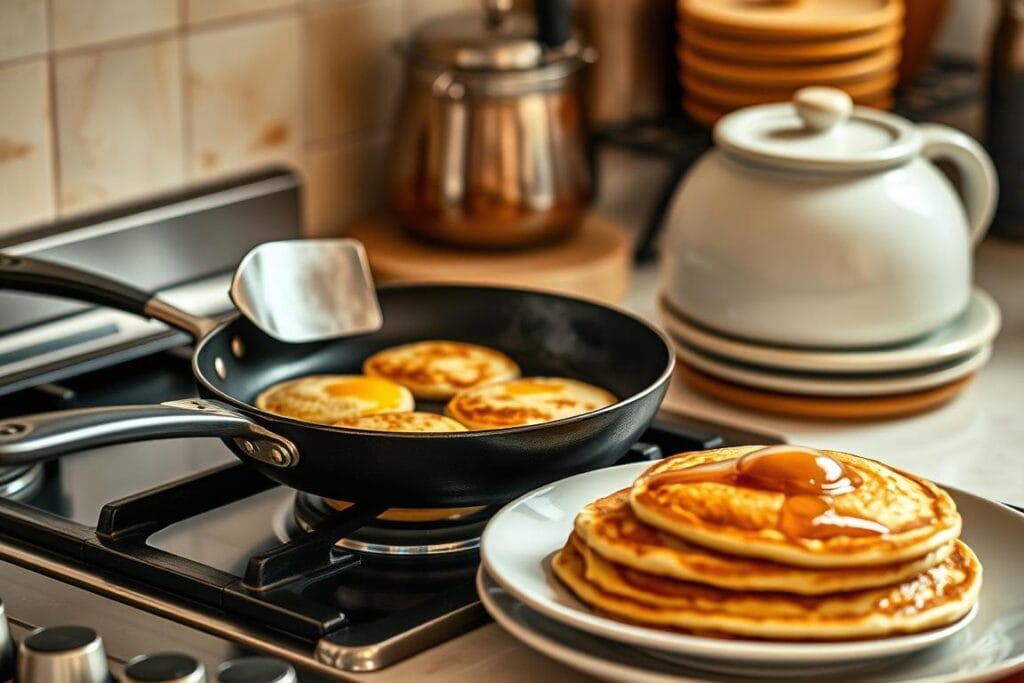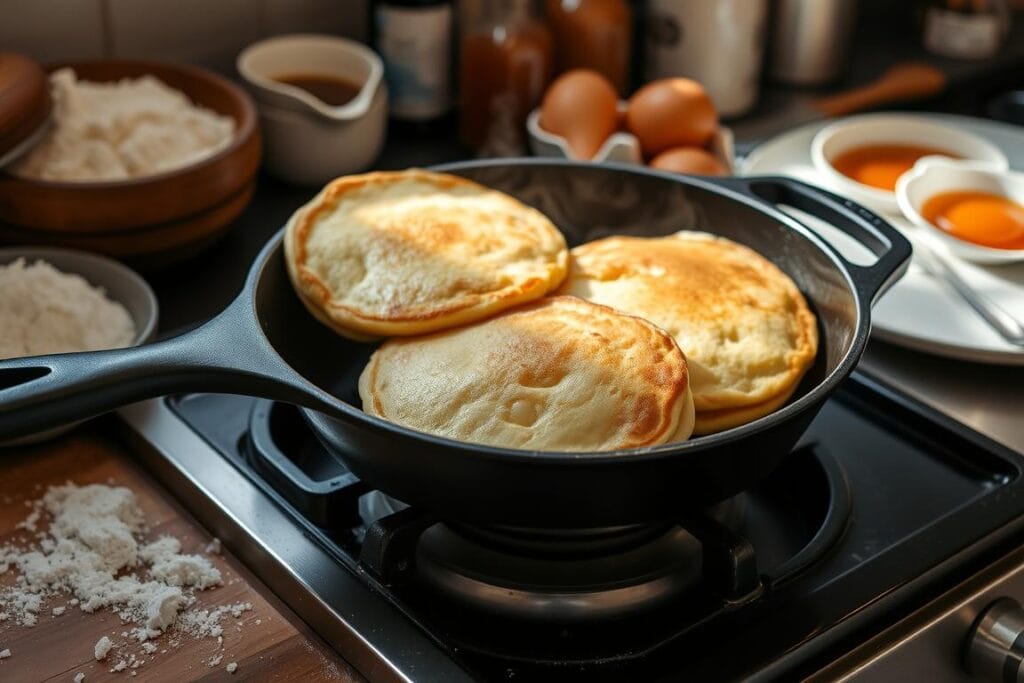Key Takeaways
- Medium heat (around 375°F) is ideal for pancake cooking
- Preheat your skillet before adding pancake batter
- Avoid high heat to prevent burning
- Look for bubbles forming on the pancake surface as a cooking indicator
- Room temperature ingredients help create fluffier pancakes
- Proper heat control prevents tough, dense pancakes
The Importance of Proper Heat Settings for Perfect Pancakes
Making fluffy pancakes is an art that starts with temperature control. The heat setting is key to a great breakfast dish. It affects the pancake’s texture, color, and quality.

Temperature is crucial for turning simple buttermilk pancakes into something special. Here are the main points of heat management for better pancake-making:
Understanding Temperature Control
The perfect cooking temperature for pancakes is in the medium range. This spot ensures:
- Even cooking throughout the pancake
- Golden-brown exterior
- Perfectly fluffy interior
- Consistent heat distribution
Impact on Pancake Texture
The pan’s temperature affects the pancake’s texture. Too high heat can burn the outside and leave the inside raw. Low heat makes pancakes pale and undercooked, lacking crispiness.
According to Alex’s Recipes’ American Giant Pancakes Guide, preheating ensures even heat distribution, allowing pancakes to cook thoroughly without sticking or burning.
Common Temperature Mistakes
“Patience is key when cooking pancakes. Rush the process, and you’ll compromise quality.” – Chef Sandy Davis
Avoid these common temperature mistakes:
- Skipping pan preheating
- Overcrowding the cooking surface
- Flipping pancakes too early
- Not adjusting heat during cooking
By focusing on heat settings, you’ll improve your breakfast dishes. You’ll make pancakes that look good and taste great.
Medium Heat: The Golden Standard for Pancake Cooking

Medium heat is key for making perfect american breakfast diner classics. It heats up to about 375°F. This temperature turns your batter into golden-brown pancakes that are true comfort food.
Medium heat makes pancakes with:
- Evenly cooked interiors
- Crispy, golden-brown exteriors
- Consistent texture throughout
- Perfect bubble formation
“The key to pancake perfection is patience and the right temperature”
Your pan should be just right. Try dropping cold water on it. If it sizzles and dances, you’re good to go. This method makes sure your pancakes cook just right.
| Heat Level | Pancake Outcome |
|---|---|
| Low Heat | Pale, undercooked center |
| Medium Heat | Golden-brown, fully cooked |
| High Heat | Burnt exterior, raw interior |
Pro tip: Look for bubbles on the surface. When they start popping and leave small holes, it’s time to flip. This visual clue helps you keep the perfect cooking rhythm.
Essential Equipment for Temperature Control
Making the perfect pancake recipe is more than just skill. It’s about choosing the right cooking tools. Your breakfast dishes depend on how different cooking surfaces affect your cooking and breakfast experience.
Your choice of cooking surface can greatly affect your pancakes. Each tool has its own benefits for making tasty breakfast treats.
Electric Griddle Advantages
Electric griddles are great for pancake lovers:
- Consistent heat distribution
- Large cooking surface
- Precise temperature control
- Easy cleaning
Cast Iron Skillet Techniques
Cast iron skillets add a traditional touch to your cooking. They keep heat well and make pancakes golden-brown. Proper seasoning is crucial to avoid sticking and ensure smooth cooking.
Non-stick Pan Options
Non-stick pans are easy for home cooks. Their special coating prevents burning and makes flipping pancakes easy.
| Cooking Surface | Heat Control | Maintenance |
|---|---|---|
| Electric Griddle | Excellent | Easy |
| Cast Iron Skillet | Good | Requires Seasoning |
| Non-stick Pan | Moderate | Very Easy |
“The right pan transforms a good pancake into a great breakfast experience.”
Choose your cooking equipment carefully to improve your pancake-making skills. This will help you create unforgettable morning meals.
Mastering American Giant Pancakes: Size and Heat Balance
Making the perfect american giant pancakes is more than just mixing ingredients. It’s about finding the right balance of heat and size. These diner classics need special care in cooking.
When making large pancakes, managing heat is key. Start with a lower heat to cook the center fully without burning the edges. This way, the outside stays soft while the inside cooks right.
- Pour about 1/4 cup of batter per pancake
- Make sure there’s enough space between pancakes for them to spread
- Look for bubbles on the surface
- Flip when the edges are dry
Professional chefs share some top tips for making giant pancakes:
- Use a well-seasoned cast iron skillet for even heat
- Preheat your pan to a medium-low temperature
- Lightly grease the pan with butter or oil
“The secret to perfect pancakes is patience and precise heat control.” – Breakfast Cooking Expert
Your aim is to get pancakes that are golden on the outside and soft inside. With careful attention to heat and technique, you’ll make a breakfast that’s unforgettable.
Signs Your Pan Temperature is Just Right
Mastering the perfect pancake recipe is all about heat management. To make fluffy pancakes, you need to know when your pan is ready. Look for visual cues that show your pan is at the perfect temperature.
Visual Temperature Signals
When making an authentic American breakfast, watch for these signs:
- Water droplets should sizzle and evaporate quickly on the pan surface
- The pan should have a light, even heat without smoking
- A gentle, consistent warmth across the entire cooking surface
Timing and Bubble Guidelines
Professional chefs suggest these timing tips for perfect pancakes:
- Cook for 2-3 minutes on the first side
- Look for small bubbles forming across the surface
- Wait until bubbles start to pop before flipping
Bubble Formation Signals
Bubble formation is your pancake’s secret communication method. When bubbles form consistently and start to pop at the surface, it signals that your pancake is ready to flip. The electric griddle set at 375 degrees provides the most predictable cooking environment for achieving golden-brown perfection.
“The first pancake is always a temperature test – use it to calibrate your cooking surface!” – Breakfast Cooking Experts
By paying attention to these visual and timing cues, you’ll improve your pancake-making skills quickly.
How to Achieve the Perfect Golden-Brown Color
Getting the perfect golden-brown color for your pancakes is an art. It’s all about mastering heat control and understanding pancake preparation. This is key in diner classics and homestyle cooking.
To get that golden hue, follow these steps:
- Use medium heat for consistent caramelization
- Wait for bubbles to form across the entire surface
- Watch for dry edges as a flipping signal
- Avoid pressing down on pancakes during cooking
Your batter is important for color. A small amount of sugar aids caramelization. This creates the golden-brown exterior that makes pancakes so comforting.
| Color Indicator | Cooking Action |
|---|---|
| Pale and undercooked | Increase heat slightly |
| Too dark or burning | Reduce heat, clean griddle |
| Perfect golden-brown | Maintain current heat setting |
“The magic of pancakes is in their golden-brown perfection – a delicate balance of heat, time, and technique.”
Professional chefs say to use a non-stick surface and watch your pancakes closely. A well-seasoned cast-iron skillet or electric griddle helps get consistent, beautiful results every time.
Temperature Adjustments for Different Pancake Batters
Creating the perfect buttermilk pancakes is all about heat. Not all pancake recipes are the same. Learning to control the temperature can make your breakfast dishes amazing.
Buttermilk Batter Nuances
Buttermilk pancakes need special heat settings. Their acidic nature means they burn easily. Cook them at 325-350 degrees Fahrenheit for fluffy pancakes with a golden-brown look.
- Preheat your griddle carefully
- Watch for subtle bubble formation
- Adjust heat to maintain consistent cooking
Whole Wheat Pancake Considerations
Whole wheat pancakes cook best at lower heat. This prevents burning and ensures they cook well. Aim for 325 degrees.
Gluten-Free Batter Heat Management
Gluten-free pancakes need higher heat for browning. Without gluten, they need careful heat to get that golden color.
| Batter Type | Ideal Temperature | Cooking Time |
|---|---|---|
| Buttermilk | 325-350°F | 2-3 minutes per side |
| Whole Wheat | 325°F | 3-4 minutes per side |
| Gluten-Free | 350-375°F | 2-3 minutes per side |
“The secret to perfect pancakes is understanding your batter’s unique heat requirements.” – Breakfast Cooking Expert
Always test a small pancake first and adjust your heat. Letting your batter rest for 5-10 minutes before cooking helps. This makes your pancakes more consistent and tasty.
Common Heat-Related Pancake Problems and Solutions
Making the perfect fluffy pancakes for breakfast can be hard. Knowing how to handle heat issues is key. It turns a simple pancake recipe into a tasty morning dish.
“Pancake perfection is all about temperature control and knowing how to troubleshoot common cooking issues.”
Now, let’s look at the most common pancake problems and how to fix them:
- Uneven Cooking: Make sure your cooking surface is even and heat spreads out well
- Burning Pancakes: Turn down the heat a bit and use a timer to avoid overcooking
- Raw Centers: Lower the heat and cook for longer to get thicker pancakes
- Pale Pancakes: Increase the heat slowly to get them golden brown
Experts say to keep the heat at medium-low. Don’t overcrowd your pan. Leave enough space for each pancake to cook evenly.
| Problem | Solution |
|---|---|
| Inconsistent Heat | Use an electric griddle with temperature control |
| Sticky Pancakes | Use a non-stick pan or a light butter coating |
| Batter Thickness | Adjust the heat based on the batter’s consistency |
Remember, the more you practice, the better you’ll get. Keep an eye on the heat and adjust as needed. Soon, you’ll make fluffy pancakes just like in a restaurant.
The Role of Resting Time and Batter Temperature
Creating the perfect fluffy pancakes starts with understanding the science behind batter preparation. The resting time for pancake batter can greatly improve your cooking results.
Professional chefs know that letting pancake batter rest is crucial for achieving light and airy textures. Here’s why resting matters:
- Allows flour to fully hydrate
- Activates leavening agents
- Relaxes gluten proteins
- Creates smoother batter consistency
The ideal resting time for your pancake recipe is 5-10 minutes. During this time, the flour absorbs liquid, making pancakes more tender. Room temperature ingredients are key to creating the perfect batter.
“Good pancakes are about patience, not just ingredients” – Breakfast Cooking Wisdom
| Resting Time | Pancake Characteristics |
|---|---|
| 0-2 minutes | Thin, less fluffy texture |
| 5-10 minutes | Optimal thickness and fluffiness |
| 15+ minutes | Minimal additional improvement |
Pro tip: Avoid overmixing your batter. A slightly lumpy mixture actually contributes to lighter, more tender pancakes. Your breakfast will thank you for this careful approach to homestyle cooking!
Professional Tips for Consistent Heat Management
Mastering diner classics like pancakes needs precision and skill. Professional kitchens use special techniques for perfect american breakfasts. They focus on consistent heat and batch cooking.
Homestyle cooking experts use several key strategies for tasty pancakes:
- Use large griddles with precise temperature control
- Maintain steady heat throughout cooking process
- Implement strategic griddle rotation techniques
Restaurant Cooking Techniques
Professional chefs suggest specific ways to make pancakes:
- Preheat griddle to exactly 375°F
- Use clarified butter for even greasing
- Employ squeeze bottles for uniform batter distribution
Batch Cooking Methods
Successful batch cooking needs careful heat management and planning:
| Technique | Benefit |
|---|---|
| First Pancake Test | Checks griddle temperature and adjusts as needed |
| Griddle Rotation | Ensures even heat distribution |
| Batter Resting | Improves pancake texture and fluffiness |
“The secret to perfect pancakes is consistent heat and patience.” – Professional Chef
Pro tip: Always let your batter rest for 30 minutes. This helps with gluten relaxation and leavening agent activation.
Temperature Variations for Special Pancake Types
Making the perfect pancake means knowing how to adjust the heat. Different types need different temperatures. This is especially true for big american giant pancakes or light buttermilk pancakes.
Each pancake style needs a special cooking method. Let’s see how heat affects different types:
- Thin Crepes: Need high heat for quick cooking and crisp edges
- Fluffy Pancakes: Work best with lower, controlled temperatures
- Pancakes with Mix-ins: Require slightly lower heat to avoid burning add-ins
Let’s look at the special qualities of different pancake types:
| Pancake Type | Ideal Temperature | Cooking Technique |
|---|---|---|
| Dutch Baby Pancakes | 425°F initial, then 375°F | Start in hot oven, finish at lower temperature |
| Buttermilk Pancakes | 375°F | Medium heat for even cooking |
| American Giant Pancakes | 350°F | Lower heat to ensure thorough cooking |
“The secret to perfect pancakes lies in mastering temperature control” – Professional Chef
When making your pancake recipe, pay close attention to each type. The right heat makes them golden outside and fluffy inside. It turns simple ingredients into a tasty breakfast.
Conclusion
Making perfect pancakes is an art in homestyle cooking. It turns a simple breakfast into a delightful diner classic. Your journey to making restaurant-quality pancakes begins with understanding temperature, batter, and cooking techniques.
Temperature is key to golden-brown pancakes with a tender inside. Medium heat, around 375°F, is perfect for rich flavors and texture. Whether using buttermilk, whole wheat, or specialty batters, watch your pan’s heat. This ensures each pancake is light, fluffy, and delicious.
Practice and patience are essential in mastering American breakfast pancakes. Experiment with heat settings, understand ingredient interactions, and improve your technique. Soon, your kitchen will become a pancake paradise. Remember, every great cook started somewhere, and with dedication, you’ll make pancakes that rival diner favorites.
Don’t forget to experiment with different recipes like those featured in Alex’s Recipes, such as their American Giant Pancakes, to add variety to your breakfast table.
Enjoy the joy of cooking and let your creativity shine in each pancake. Your breakfast table will become a celebration of flavor, texture, and homemade morning delights.

